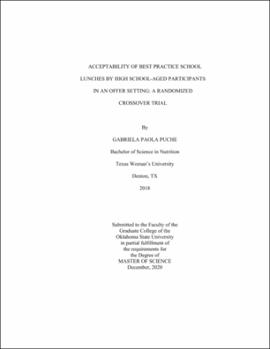| dc.contributor.advisor | Joyce, Jillian | |
| dc.contributor.author | Puche, Gabriela Paola | |
| dc.date.accessioned | 2021-05-25T20:42:25Z | |
| dc.date.available | 2021-05-25T20:42:25Z | |
| dc.date.issued | 2020-12 | |
| dc.identifier.uri | https://hdl.handle.net/11244/329972 | |
| dc.description.abstract | BACKGROUND: A barrier to improving school lunch dietary quality (DQ) is perceived low acceptability, as participation, selection, and plate waste, in school settings. The purpose of this study was to investigate differences in acceptability of National School Lunch Program (NSLP)-qualifying lunches of high [Healthy Eating Index (HEI)=90-95/100, best practice school lunch, BPSL] and moderate (HEI=75/100, typical school lunch, TSL) DQ in a controlled offer setting by high school-aged children. | |
| dc.description.abstract | METHODS: This randomized crossover trial included convenience sample of 40 high school-aged students recruited from NSLP-participating schools. Instruments included hunger scale, selection record, taste test survey (TTS), and weighted plate waste assessment. Participants were randomized into three groups, attending three meal conditions (MC) in different order. Each MC had two options for each NSLP meal component: 1) BPSL/BPSL, 2) TSL/TSL, 3) BPSL/TSL. | |
| dc.description.abstract | RESULTS: Before controlling for covariates, there were no significant differences among 14 acceptability measures when comparing all three MC. After controlling for BMI percentile, usual diet, and meal group, three significant differences in acceptability emerged, including texture TTS subscore, change in hunger score, and milk plate waste. Additionally, when looking at differences in acceptability in MC3 with increasing percentage of BPSL options chosen, there was only one significant difference, "serve at school" TTS subscore. With regression analysis, no significant relationship was detected between percentage of BPSL options chosen and "serve at school" subscore. | |
| dc.description.abstract | DISCUSSION: Results suggest minimal differences in acceptability between BPSL and TSL, when served alone or in combination, among high school students in a controlled offer setting. | |
| dc.format | application/pdf | |
| dc.language | en_US | |
| dc.rights | Copyright is held by the author who has granted the Oklahoma State University Library the non-exclusive right to share this material in its institutional repository. Contact Digital Library Services at lib-dls@okstate.edu or 405-744-9161 for the permission policy on the use, reproduction or distribution of this material. | |
| dc.title | Acceptability of best practice school lunches by high school-aged participants in an offer setting: A randomized crossover trial | |
| dc.contributor.committeeMember | Hildebrand, Deana | |
| dc.contributor.committeeMember | Hermann, Janice | |
| osu.filename | Puche_okstate_0664M_16810.pdf | |
| osu.accesstype | Open Access | |
| dc.type.genre | Thesis | |
| dc.type.material | Text | |
| dc.subject.keywords | child nutrition | |
| dc.subject.keywords | dietary quality | |
| dc.subject.keywords | food attitudes | |
| dc.subject.keywords | school lunch | |
| thesis.degree.discipline | Nutritional Sciences | |
| thesis.degree.grantor | Oklahoma State University | |
